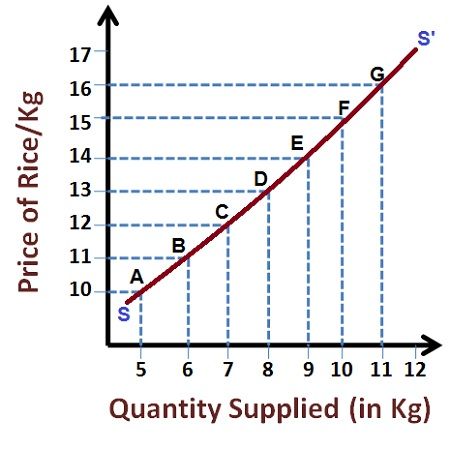Definition: The Law of Supply posits that there is a positive relationship between the supply of a commodity and its price, such that the supply of the commodity increases with the increase in its price and decreases with the fall in its price, other things remaining constant.
Here, “other things” are the factors that influence the supply of the commodity such as technology, input prices, price of related products, nature and size of the industry, government policy, etc. The law of supply is based on the notion, that as the price of a product increases the suppliers with an objective to maximize their profits increases the production of a commodity for sale.
The concept of the law of supply can further be illustrated by Supply Schedule and Supply Curve.
Supply Schedule: The supply schedule is the tabular representation of the different prices of the commodity and the corresponding quantities that the suppliers are willing to offer for sale. A hypothetical daily supply schedule of rice is given below:
| Price of Rice/Kg | Supply of Rice/day (In Kg) | Price quantity combinations |
|---|---|---|
| 10 | 5 | A |
| 11 | 6 | B |
| 12 | 7 | C |
| 13 | 8 | D |
| 14 | 9 | E |
| 15 | 10 | F |
| 16 | 11 | G |
The law of supply is well substantiated through the table above, which shows that the supply of rice increases with the increase in the price. Such as when the price of rice is Rs 14/ kg the supply of rice is 9/Kg and as the price rise to Rs 15/kg the supply also increases to 10/kg.
Supply Curve: The supply curve is the graphical representation of the supply schedule which shows different combinations between the price and the quantity supplied.

SS’ is the upward sloping supply curve, which depicts the law of supply, i.e. the supply of rice increases with the increase in its price.

Leave a Reply